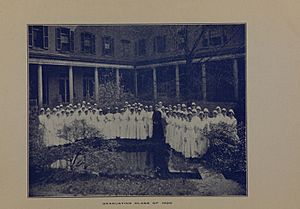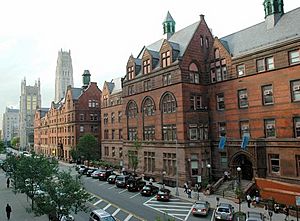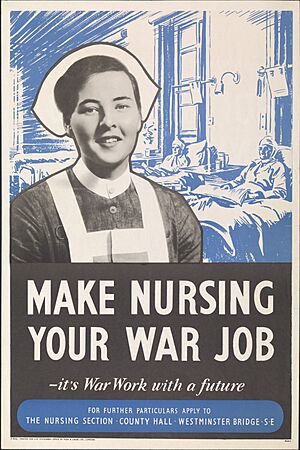Mary Adelaide Nutting facts for kids
Mary Adelaide Nutting (born November 1, 1858 – died October 3, 1948) was a Canadian nurse and teacher. She was a very important person who helped create modern hospital care. After finishing her nursing training at Johns Hopkins University in 1891, Nutting helped start a new nursing program there.
In 1907, she joined an exciting new program at Teachers College at Columbia University. She became the head of the nursing and health department. Nutting created a new kind of learning plan for nurses. It included basic nursing skills, public health, and helping people in their communities. She led many groups and committees that helped make nursing education the same everywhere. She also worked with laws to improve nursing.
Nutting wrote many important books and articles about nursing. Her book, A History of Nursing, is still a key historical writing today. People remember her as a pioneer in nursing. She was also an activist who fought for women's rights when they didn't have many.
Contents
Early Life and Education
Mary Adelaide Nutting was born in November 1858 in Frost Village, Quebec, Canada. Her parents, Vespasian and Harriet Sophia Nutting, were from England. Her family were Loyalists who moved to Canada from the US. This was common for people who stayed loyal to the British during the American Revolutionary War. After the US won, they moved to Quebec, which was a British colony.
Mary was one of six children. She was very close to her only sister, who also loved arts and music. When Mary was young, her family moved to Waterloo. She spent most of her childhood there.
Schooling and Early Career
Even though her family didn't have a lot of money, all the children went to the local village school. Nutting's father was a court clerk, and his income made it hard to pay for everything. But he believed that school was very important for his children.
Nutting was a talented student who loved to learn. She studied at the Bute House School in Montreal. She also spent a short time at a convent school in St. Johns, Newfoundland. In 1881, Nutting, her mother, and her siblings moved to Ottawa. There, she became interested in music and design. She studied art briefly in Lowell, Massachusetts, and then continued her studies back in Ottawa.
Nutting's sister was the principal at the Cathedral School for Girls. This gave Nutting her first chance to teach. She spent a year teaching piano and music. She was known as a very independent woman. She decided early on not to marry, so it wouldn't stop her career goals.
Nursing at Johns Hopkins University
Nutting first loved the arts. But she greatly admired Florence Nightingale, a British nurse who helped create modern nursing. This made Nutting interested in nursing. She also saw her mother slowly die because of "incompetent" health care. This sad experience made her even more determined.
By chance, she saw a newspaper ad for a new nurse training program. It was at Johns Hopkins University in Baltimore.
Joining the Johns Hopkins Program
In October 1889, at age 31, Nutting was one of 17 students to join the first class at the Johns Hopkins School of Nursing. This training program was special because you didn't need any past experience or college education to get in. Also, students who didn't have much money could still attend. Instead of paying tuition, students worked at the hospital and got a small salary.
Nutting graduated from Johns Hopkins in 1891. She was fourth in her class. She decided to stay at the hospital and became a head nurse. In 1893, Nutting was promoted to assistant superintendent. She worked under her friend Isabel Hampton. When Hampton resigned a year later, Nutting became the superintendent and principal of the nursing school. This meant she led both the school and the hospital's nursing services.
Improving Nursing Education
In her new leadership role, Nutting saw a chance to make big changes at Johns Hopkins. She also wanted to improve nursing education across the country. One person said about her becoming superintendent: "Thus began her lifelong crusade to bring education of nurses within universities."
A big problem at the Hopkins training school was that students spent too much time working in the hospital. They didn't spend enough time on their studies. This was unfair to students who wanted a serious academic program. Instead, they were used as cheap extra staff for the hospital. Also, these students were put to work without much training. This could lead to poor patient care. They worked about 60 to 105 hours a week. This left almost no time for schoolwork.
In 1893, the Johns Hopkins Medical School was founded. This made people focus more on the need to improve existing practices. To fix the problems in her own program, Nutting met with the trustees in 1895. She explained how the current system was "exploitative," meaning it took advantage of students.
Nutting used detailed facts and figures in her report, The Statistical Report of Work Hours in Training School. This report showed the problems of using students as hospital staff. Her presentation was called the "Magna Carta" of nurse teaching. It convinced the Hopkins leaders to make big changes. Student salaries were replaced with scholarships. The training school became a three-year program with fewer work hours.
Nutting also started an important preparatory program. It helped nurses get ready for the hospital environment. It included classes in anatomy, physiology, materia medica (medicine), and hygiene. This was one of the first programs of its kind. Nutting also made early progress in public health. She started nursing programs that provided home care for people in poorer communities, especially sick mothers.
Finally, Nutting helped create the Johns Hopkins' Nursing Library. The books there later became important for her own book, History of Nursing. This four-volume series was written from 1907 to 1912. She wrote it with Lavinia Dock. It gave a full history of nursing up to that time.
Teachers College at Columbia University
Nutting's main goal was to connect nurse training schools with university education. She knew this wouldn't happen during her time at Hopkins. So, in 1889, Nutting convinced the new dean at Teachers College at Columbia, James E. Russell, to let nurses take hospital economics and physiology classes there.
Teachers College was the first school of education in the country. Nutting believed nurses who wanted to teach or become administrators would learn a lot from studying there. At first, she traveled between Baltimore and New York City. She taught part-time at both universities.
In 1907, Nutting was very successful at Columbia. She took a full-time job as a professor in institutional management. This was a historic achievement. She was the first nurse to ever become a department head at a university. Johns Hopkins was sad to lose such an important person in medicine. But they knew Nutting would still help Maryland.
In 1910, she became the chairman of the department of nursing and health. Dean Russell called Nutting "one of the ablest men of either sex." As chairman, Nutting created a famous program in hospital administration and nurse education. She believed in a "humanistic approach" to nursing. This meant nurses were both medical professionals and social workers.
In 1920, Nutting was honored for her work with the Adelaide Nutting Historical Collection at Teachers College. This collection had many works about her long-time hero, Florence Nightingale. In 1925, she retired from her position as chair. Even today, Nutting is remembered as one of the most important people in developing the nursing program at Columbia.
Important Books and Articles
Mary Adelaide Nutting is perhaps the most important person in developing modern nursing. Besides creating learning plans and doing administrative work, she also wrote many important books and articles. These writings are still crucial for nursing studies. One bibliography says, "Every significant nursing study published in the early 1900s was associated in some way with Adelaide Nutting."
Here are some of her most important works:
- A History of Nursing (1907–1912)
- Educational Status of Nursing (1912)
- Standard Curriculum for Schools of Nursing (1917)
- Nursing and Nursing Education in the United States (1923)
- A Sound Economic Basis for Schools of Nursing (1926)
Helping During World War I
Even though she was a Canadian citizen, Mary Adelaide Nutting was eager to help when war started in Europe. In 1917, when the US joined WWI, she gathered the National Emergency Committee on Nursing. This committee helped with the war effort.
Also, President Woodrow Wilson made her the chairman of the committee on nursing for the medical board of the Council of National Defense. In this role, Nutting made sure there were enough nurses to support the soldiers. She also made sure they had the right tools to treat patients. Through newspaper articles, she asked the public to help with the war efforts. Nutting's way of organizing was used again during WWII because it worked so well before.
After the war, Nutting received the Liberty Science Medal. The Council of the National Institute for Social Sciences gave it to her. The award praised her patriotism and dedication to the war effort.
Legacy and Awards
People who knew Nutting remember her as independent, driven, and passionate. She died from pneumonia in October 1948, in White Plains, New York. This was just before her 90th birthday. She had a traditional Anglican ceremony, and her ashes were buried at sea.
Mary Adelaide Nutting led the nursing community for over 30 years. Her impact on the field is still strongly felt today. At a graduation ceremony at Yale University, the professor introducing Nutting called her "one of the most useful women in the world."
Nutting was involved in many women's rights movements and programs. She also strongly believed in making education and medical care available to everyone. She was a pioneer in education, hospital management, and other areas. In 1944, a medal was named after her. The National League of Nursing presents the "Mary Adelaide Nutting Award" once a year. It is given to someone who has shown dedication and helped improve nursing education.
Images for kids
See also
 In Spanish: Mary Adelaide Nutting para niños
In Spanish: Mary Adelaide Nutting para niños











